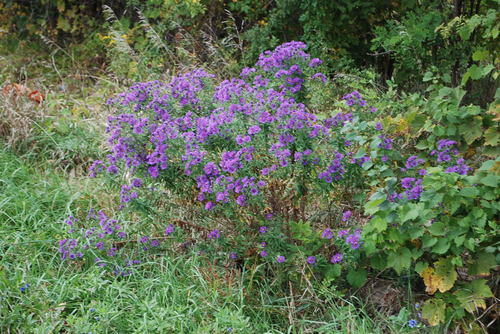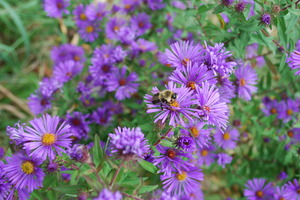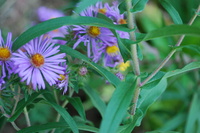Ann Arbor Native: A purple splash of New England comes to Michigan
You’re driving along a country road around about now when suddenly you’re taken aback by a stunningly beautiful, deep purple plant or collection of such plants, along the roadside.

New England aster (Symphotrichum novae-angliae) showing its stuff along Miller Road near Dexter
Rick Meader|Contributor

A bumblebee grabs a mid-afternoon Aster snack
Rick Meader|Contributor
According to the U.S. Department of Agriculture fact sheet on the plant , and other things I’ve read, it prefers damper areas, including roadside ditches, low areas, wet meadows and thickets, so it would be a great member of a rain garden. I’ve had little problem in having it grow very well in my soils, which aren’t sandy, but get quite dry and are rarely saturated.
It can grow to 6’ tall in optimum conditions, but I usually see it closer to 3-4’ tall. If you want to avoid it becoming gangly when it blooms, you can hack it back to one-third to half its height in June to make it a more bushy plant that will still bloom very well that fall. It will still grow back to about 3’ tall, but will be more compact. If you do let it go, and conditions allow it, it may lean way down with the weight of the flowers, especially after a heavy rain.
New England aster was used by many Native Americans for a variety of uses, including as a poultice for pain, a treatment for catarrh, and as a love medicine, among other uses, according to the University of Michigan-Dearborn’s ethnobotany website. (http://herb.umd.umich.edu/herb/search.pl?searchstring=Symphyotrichum+novae-angliae) It is native to almost all of the United States and much of Canada (http://plants.usda.gov/java/profile?symbol=SYNO2&mapType=nativity&photoID=asno_002_ahp.tif) and will probably spread around your yard if you plant some — it has in my yard.
This aster is a magnet for bees and butterflies. As you can see on the first photo, bumblebees love it, but so do may other bees, large and small, butterflies and moths. Its yellow center makes it a great plant for Ypsilanti High School supporters to have in their yard, showing off the school colors. The flowers get to about 1-inch wide, and each plant puts out a multitude of flowers, so it really makes a great show when you can use some color against a grey or blue fall sky.
The leaf of this aster is quite distinctive and helps with identification. It’s a narrowly triangular leaf that clasps the hairy stem and can reach 4-inches long. Asters aren’t just around to be pretty. They are also a host for Pearl Crescent butterflies and the Saddleback caterpillar moth. They don’t start to bloom until late August or September, but hold on through October, for a strong display.

New England aster's leaves clasping its hairy stem
Rick Meader|Contributor
This plant is readily available from both Native Plant Nursery and Wildtype Nursery, but you can probably get it going in your yard by gathering some seeds along the roadside and tossing them around your yard as, it is a good self-seeder. If you want to have some control in where it appears, however, buying some from those vendors and planting them where you want it is a more focused way to establish it in your landscape. By the way, you may also be seeing a lighter purple, more lavender aster along the roadside about now. We’ll talk about that one next week. Stay tuned!
This week, blooming in my yard, either effusively or just hanging on, are: New England aster, smooth aster, calico aster, heath aster, heart-leaved aster, arrowhead aster, canada goldenrod, bluestem goldenrod, white snakeroot, obedient plant and, still, brown-eyed Susan.
Enjoy nature, everyone!
Rick is a local landscape architect with a special interest in all things natural, including native plants and the critters that eat them. You can contact him at yourland1824@gmail.com


Comments
Rick Meader
Sat, Oct 9, 2010 : 8:14 a.m.
Early October is a great time of year for color, for sure. Look up, too. The trees are really starting to change!
81wolverine
Fri, Oct 8, 2010 : 7 a.m.
Very interesting article! This has been a great year for the New England asters in our Lodi Township area. There are LOTS of them, which is beautiful. You "sort of" addressed a question I had about the lighter, lavender colored ones - I guess I'll have to wait until next week!
RhondaM
Thu, Oct 7, 2010 : 9:35 p.m.
I love the wildflowers in the area! There are so many simple joys we can find daily, if we just look on the side of the road;)